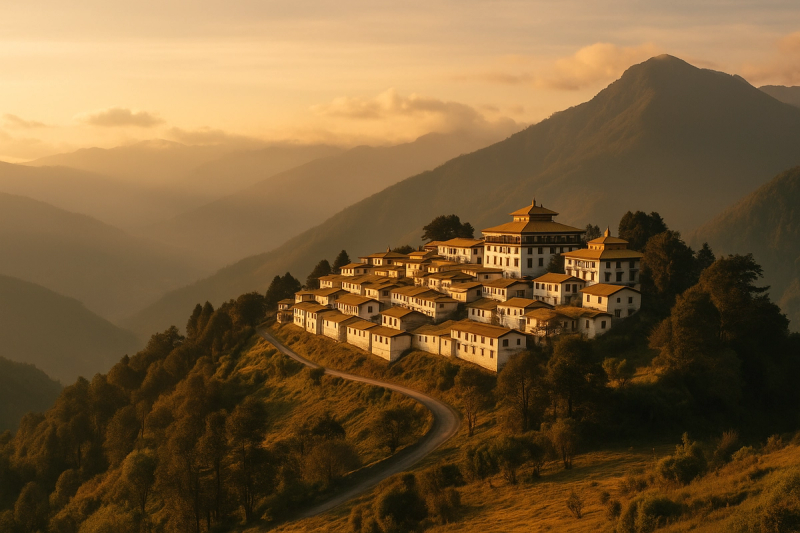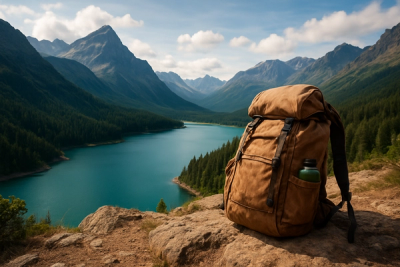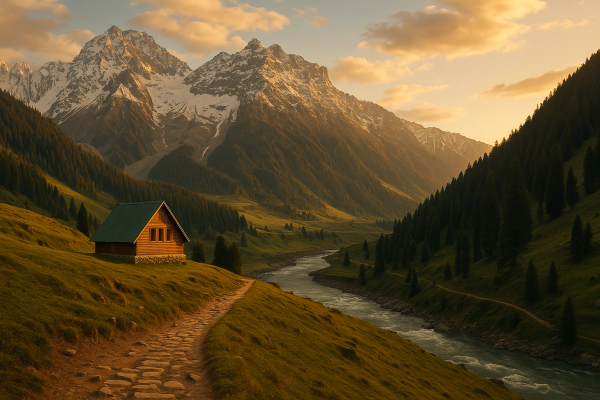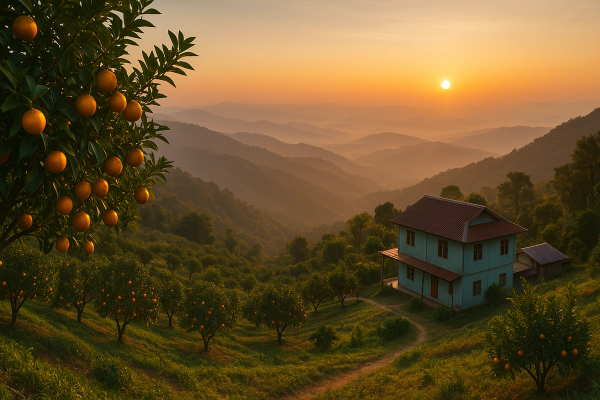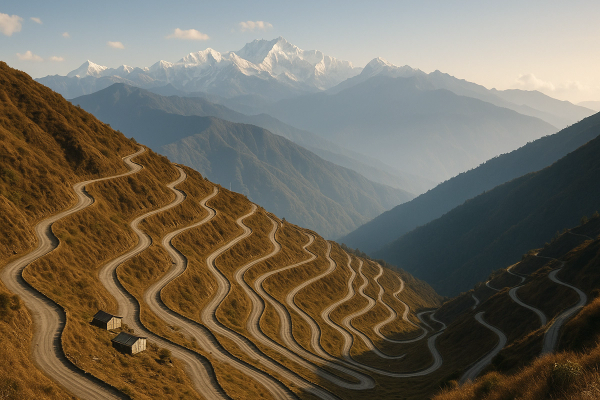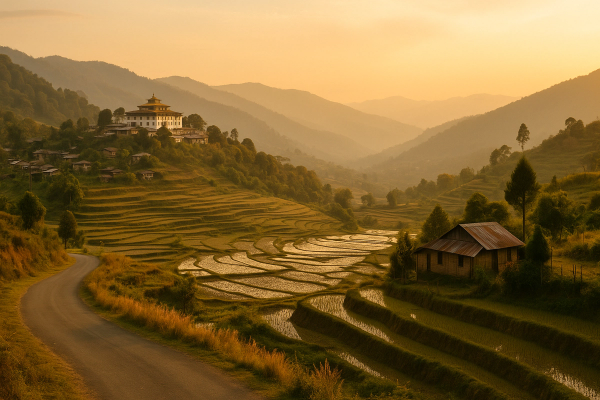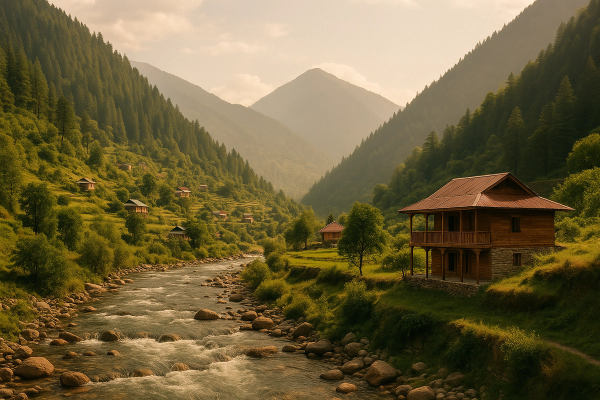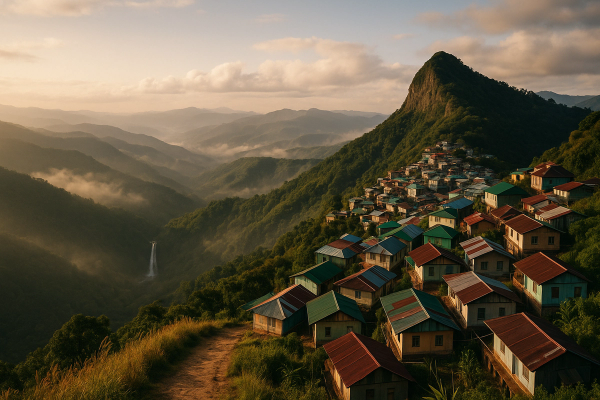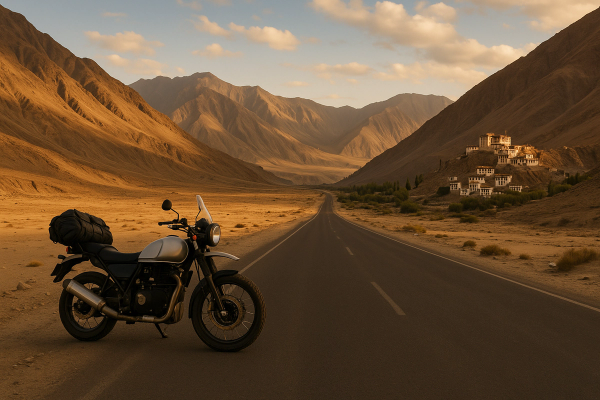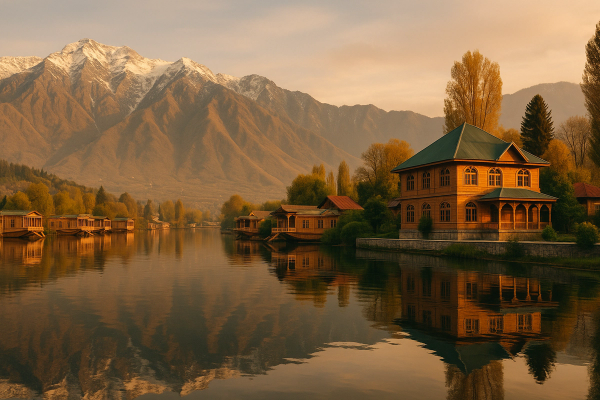Tawang Travel Guide: How to Reach, Permits & Monasteries — what actually worked for me#
I won’t lie, the first time I saw the road sign that said Bhalukpong Gate ahead, my heart started doing bhangra. That’s the entry to Arunachal for most of us folks coming up from Assam. The air itself felt different. Thicker with pine and diesel and that monsoon-smell of wet earth. I had my Inner Line Permit printed and also on my phone, two cups of sweet chai inside me, and a backpack that weighed like regret. Basically, I was ready. Tawang had been sitting in my head since college, all prayer flags and snow and those golden monastery roofs that glow even when the sky is grey. This is the guide I wish someone had shoved into my hands before I started — how to reach, which permits you actually need, the monasteries that matter, and a few little truths you don’t find on glossy websites.¶
The vibe: prayer flags, Army trucks, and thin air that hits like a reality check#
Tawang sits at around 3,050 m, which sounds like just a number till your breath gets short walking uphill to buy momos. The vibe here is a proper mix — Monpa villages with stone walls and wood smoke, army convoys rumbling through, monks in maroon robes zipping past on scooters, and the weather changing its mind every 15 minutes. Morning sun. Noon fog. Evening drizzle. Night stars that look fake. Don’t underestimate the altitude. First day, I did the classic tourist mistake, me and my friend climbed those monastery stairs like we’re in a fitness ad, and boom, instant headache. Nothing scary, just… slow down. Sip water. Soup over soda. Day 1 is for acclimatizing, not conquering everything.¶
How to reach Tawang right now (roads, helicopter, and the route locals actually use)#
The classic route is Guwahati to Tawang via Bomdila or Dirang, split over two days. Distance is around 440–500 km depending on which road you take. Most people do Guwahati to Dirang day 1, Dirang to Tawang day 2. Tezpur is another jump-off, but honestly Guwahati has more flights and better car options. The big update — as of 2025 the Sela Tunnel is operational. It cuts through the mountain and avoids the highest, iciest bit of Sela Pass during bad weather. Travel time is shorter on a good day, and more importantly, fewer season shutdowns. Still, carry patience. Landslides love this region, especially June to September. For transport, you’ve got options: 1) Shared Sumo/Traveller from Tezpur or Guwahati, super popular with locals and budget travelers. Fares change but expect roughly ₹1,200–1,800 Tezpur to Tawang, ₹900–1,400 Guwahati to Bomdila, and another ₹1,000–1,500 Bomdila/Dirang to Tawang. They leave early morning, seats are snug, vibes are real. 2) Private cab for the whole circuit, typical 5–6 day hire costs ₹22,000–₹35,000 depending on vehicle and season, fuel extra sometimes. Worth it if you’re a group or want random photo stops. 3) Self-drive is doable if you’re confident on mountain roads, but check your rental’s rules for Arunachal. Some companies won’t allow it or need extra docs. Also don’t attempt night driving up there. 4) Helicopter: there’s a state-run Pawan Hans heli link between Guwahati and Tawang on select days. Bookings open online and at counters, weather cancels it like cricket matches in monsoon. Fare varies by category, tourists pay more, think roughly ₹7,000–₹12,000 one way when seats are available. Luggage is light, and priority often goes to locals, medical needs, officials. It’s quick but not guaranteed.¶
Which road is nicer: Bhalukpong or the OKSRT shortcut?#
From the Assam side, there are two main approaches. The traditional Bhalukpong gate route is scenic and has the official ILP checkpoint where most of us enter. The newer Orang–Kalaktang–Shergaon–Rupa–Tenga stretch (locals call it the OKSRT road) is smoother and a bit shorter on many days. If conditions are good, OKSRT saves time and your spine, but you still need your ILP checked at the designated gate on your chosen route, sometimes Balemu side if you’re swinging in that way. I did Guwahati–Mangaldoi–Orang–Kalaktang–Shergaon–Rupa–Bomdila–Dirang–Tawang while going up, and returned via Bhalukpong for variety. Honestly, both were beautiful. Shergaon’s apple orchards and stone houses are an underrated tea-break stop. Dirang is a gem for night halt, warmer than Bomdila, and has hot springs and a great learning monastery. BTW, fill fuel at Bomdila or Dirang, then again at Tawang. Don’t push it. Pumps can shut randomly after dark or during supply issues.¶
Permits in plain words: ILP for Indians, PAP for foreigners#
Arunachal is not a show-up-and-walk-in kind of place. Indians need an Inner Line Permit, and it’s actually simple now. Apply online at the official e-ILP portal, upload an ID, photo, put your entry gate like Bhalukpong or Balemu, pay a small fee, and boom, you usually get approval same day or within 24 hours. Take a printout and keep a soft copy. They do check at gates and sometimes at random checkposts. If you’re driving your own car, carry RC, insurance, PUC, license, and basic spares. Foreign nationals need a Protected Area Permit for Arunachal. Easiest is via a registered tour operator, usually a minimum 2-person rule applies and certain border areas are off-limits. Tawang town and the main monastery are typically allowed with PAP, but places like Bum La are not open to foreigners. Rules can tweak, so confirm before you plan. I met a couple from Europe in Dirang who had to rework their route because their PAP excluded a section they assumed was fine — don’t be like them, double-check.¶
Bum La, PTSO, Sangetsar (Madhuri) — those extra permits and how we got them#
For the classic high-altitude day trip — Bum La Pass, PTSO Lake, and Sangetsar Lake — you need a separate permit beyond ILP. Only Indian citizens are allowed to Bum La because it kisses the Indo–China border. We got ours from the Office of the Deputy Commissioner in Tawang town, near the main market area. You need photocopies of your ILP, a government ID, and your vehicle details. There’s a small official fee, and agents outside will do the running around for a service charge if you don’t want to queue. They usually submit by noon for next-day travel. Then your driver collects Army permissions at the checkpost near the War Memorial area on the way out. Army timings are strict. Most vehicles are asked to cross the Y-Junction by late morning and return before afternoon weather acts up. Roads are now better than horror stories you read, but still bumpy and thin air is no joke. I saw a guy sprint 30 meters for a photo and then sit with his head between his knees for five minutes. Respect the mountain.¶
Monasteries: the ones that stay in your head long after you leave#
Tawang Monastery, properly called Gaden Namgyal Lhatse, is the big one. Largest monastery in India, and honestly it feels like a whole world. Founded in the late 17th century with the blessings of the Fifth Dalai Lama, it’s a living place, not some dusty relic. I went for the early morning prayers and just sat. The chanting is deep, the cymbals and long horns rolling through the halls like a heartbeat. There’s an 8-meter Buddha in the main prayer hall and a small museum with scriptures, masks, butter-lamp stands, even some old thangkas that look like they carry weather in their colors. Don’t walk in with a camera in people’s faces, and definitely remove shoes, move quietly. If a monk offers tea, accept with both hands, tiny things matter. The courtyard view over Tawang town is ridiculous when the clouds lift — all those houses snug on the hills like someone stacked them with care.¶
The smaller monasteries were my real joy. Urgelling Monastery is simple but powerful — it’s the birthplace of the Sixth Dalai Lama and it just feels… gentle. Khinmey Gompa a little outside town has these bright murals and a kind of community vibe, someone’s always fixing something or sweeping. Singsur Ani Gompa is a nunnery where we met two nuns who giggled at my friend’s shocking Assamese-accented Hindi and still served us yak-butter tea like we were relatives. Out towards the border side is Taktsang Gompa, perched on a cliff with pine forests that smell like a memory I can’t place. If you’re into festivals, Torgya in January is big and beautiful — masked dances, blessings, and the entire town showing up in their best. Losar, the New Year, shifts by lunar calendar but late winter to spring, also a great time to be there.¶
Where to stay and what it honestly costs now#
Tawang has leveled up in stays without losing its homely charm. Mid-range hotels in town center are around ₹2,500–₹4,500 a night for double rooms, sometimes with heaters included, sometimes they sneak in a heater charge at check out, so ask. Budget homestays are ₹1,000–₹1,800, and I actually prefer them because aunties feed you like it’s a competition. Upper-mid to boutique options run ₹5,000–₹8,000 in peak months and can include hot tiffin breakfasts, valley views, the works. In Dirang, try to stay near the river or in the old fort-area homestays for proper vibe. Power cuts do happen. Carry a powerbank. Network is patchy but Jio usually works in Tawang town, BSNL is the fallback, Airtel struggled for me once we left town. ATMs exist, I saw SBI and Axis, but cash can run out. UPI is popular in markets now, but signal is boss, so keep some cash buffer for fuel and food. Oh and heaters — the small rod ones barely do anything. If they have a blower or oil heater, grab it.¶
When to go: choosing between snow, rhododendrons, and clear skies#
Peak good-weather windows are October–November and March–May. In autumn the skies are crisp blue and Sela is jaw-drop gorgeous, you get that golden sun on monastery roofs. Spring brings rhododendrons, everything pops in these unreal reds and pinks, and the rivers sound louder. Winter is magical, but it’s serious business. December to February can dump heavy snow. Roads shut at times, though the Sela Tunnel means fewer total closures now. If you come for snow, be okay with plans flipping. Monsoon is lush but tricky — June to September landslides are common, visibility low, leeches in treks below the pass, and the road has a mind of its own. The upside is fewer tourists and tea everywhere. Personally I loved shoulder season late October, got clear dawns, light crowd, and that perfect chill where soup becomes religion.¶
Food that warms your bones: what to eat and where I found the good stuff#
Tawang is not a fine-dining place and thank God for that. It’s steam from noodle pots, the smell of frying momos, butter tea in steel cups, and everyone catching up about the weather. Thukpa and thenthuk are reliable. Chicken or veg, add chilli sauce, close eyes, happiness. Try gyapa khazi if you see it on a menu — a Monpa rice dish, comforting and perfect after a cold day. Smoked pork is popular across the region, so is churpi, the hard yak cheese that locals chew and kids love. I wandered into a tiny kitchen near Old Market where an uncle handed me a bowl of zan, thick porridge with meat gravy, and a little fireplace you just never want to leave. There are bakeries doing nice buns and tea-time snacks, and small cafes popping up with decent coffee now. Army canteens near popular viewpoints sometimes serve the best chai and omelette rolls. Don’t overplan food. Walk, sniff, sit.¶
Beyond the famous list: the detours that felt special#
Nuranang Falls, often called Jung Falls, is a thundering curtain of water where spray hits your face even from the viewpoint. Easy stop on the way in or out. PTSO and nearby lakes look like someone spilled the sky on the ground. Sangetsar, also called Madhuri Lake after that film shoot, is haunting — dead tree trunks poking from the water like a forest remembering itself. If you’ve time, push to Zemithang for the Gorsam Chorten, a massive stupa near the Bhutan side, and tiny villages with barley fields and gentle conversations. Near Mukto there’s an old iron bridge called Chagzam Bridge that swings a little and makes you feel like an adventurer even though kids cross it daily to school. In Dirang, the learning monastery is lovely and welcoming, and the hot springs are, um, very hot, but perfect after a cold day. I also liked just drifting the small lanes around Nehru Market in Tawang town, garlic strings and shawls and pressure cooker whistles. Real life stuff.¶
A simple 5-day plan that actually works without rushing like crazy#
Day 1: Guwahati to Dirang. Start early. Tea at Shergaon or Rupa if you go OKSRT. Keep moving, reach before dark. Walk by the river, eat something soupy, sleep. Day 2: Dirang to Tawang via Sela. Stop at the pass or tunnel exit for photos, don’t run, thin air will remind you. Reach Tawang by afternoon, check into stay, gentle stroll to the War Memorial at sunset. Day 3: Tawang Monastery morning prayers, museum, then Urgelling and Khinmey. Pace yourself. Evening at Old Market for snacks and woollens. Day 4: Bum La–PTSO–Sangetsar circuit. Leave early with permits. Back by mid afternoon, nap, then walk to a viewpoint for dusk. Day 5: Tawang to Bomdila or directly to Tezpur if you’re feeling strong. If you have a Day 6, add Zemithang or a slow day in Tawang with a nunnery visit and long lunch. Keep one buffer day in winter. The mountains don’t care about your Google Calendar.¶
Driving, safety, and other on-ground realities you should not ignore#
Bring layers. The wind can turn your bones into bells. Sunglasses and sunscreen even on cloudy days, the UV bites. If you’re self-driving, honk blind corners, yield to trucks, never tail an army convoy too close, and don’t stop in the middle of a narrow curve just for photos. Tyres should be good and pressure checked at foothills, not at 13,000 feet in freezing wind. Network will drop at random. Download offline maps and songs unless you want to listen to your own thoughts for hours. Drones are a huge no near border, don’t even try. Medical — there’s a hospital in Tawang town, and your homestay folks will know where to go. AMS can hit anyone. Hydrate, don’t binge alcohol on night 1, and if you have a prescription for Diamox, discuss with your doctor before you come. Not medical advice, just mountain common sense. Also, carry trash back with you. The lakes don’t need your chips packet.¶
Budgeting: how much I ended up spending and what’s normal now#
For a 5-night circuit Guwahati–Dirang–Tawang–Bomdila–Guwahati, two of us spent roughly this: Stays averaged ₹2,200 a night per room in homestays and ₹3,500 in a nicer Tawang hotel for one night. Food was ₹400–₹800 per person per day depending on how fancy the dinner got. Shared Sumo rides add up to ₹2,500–₹3,500 per person across legs, while a private cab quote for the whole itinerary was about ₹28,000 in shoulder season. The Bum La day trip in a local taxi cost us ₹5,500 for the vehicle including PTSO and Sangetsar, plus snacks. Permits were small change, under ₹500 total including photocopies and agent fees. Add entry fees here and there, chai, shawls your mom will absolutely demand, and you’re looking at ₹15,000–₹22,000 per person for 5–6 days if you do it sensibly in a pair. Solo on private cab will be more. Helicopter saves time but not rupees.¶
Packing: the stuff that saved me from becoming a popsicle#
Layers, not just one massive jacket. Thermal inner, fleece, windproof shell. Good shoes with grip, socks that are actually warm, and a light cap or beanie. Gloves, especially for the Bum La day. Lip balm, sunscreen, and a small moisturizer because your face will dry faster than your phone battery. Reusable water bottle. Powerbank. Small torch or headlamp because power cuts are a thing. A tiny sling bag for monastery visits so you’re not jingling haltingly with a giant backpack. Offline maps downloaded. A few snacks for long stretches with no dhaba. Cash in small notes because change is a rare species. And a plastic folder to keep ILP, permits, and extra photocopies — the number of times someone asks for a copy is honestly comedic. If you have motion sickness, carry meds. Those hairpin bends are not shy.¶
Monastery manners and local culture: don’t be that person#
Take your shoes off quietly, walk slowly, don’t block doorways for photos, and don’t poke a camera in anyone’s face during prayers. Ask before clicking portraits, most folks will smile and say yes, but it’s just nice to ask. Turn prayer wheels clockwise. Don’t yank prayer flags, they’re not decor. If you’re invited for tea, accept with both hands, even if butter tea is not your vibe, sip a little. Learn a hello or thank you in Monpa if you can, it’s fun and people appreciate it. Bargain in markets but don’t grind people down for ₹20. This isn’t Delhi Sarojini, you know. And dress warm inside monasteries too — the stone floors are cold and your fashion sandals will betray you.¶
Latest travel bits: connectivity, money, and small trends I noticed#
UPI is everywhere in towns now but flaky when the signal dips, which is often, so always keep cash for essentials. Jio worked best for me in Tawang town, BSNL was patchy but sometimes the only lifeline, Airtel got shy outside the center. ATMs exist but one was out of cash for two days, so don’t wait till the last ₹200 in your pocket. EV folks — charging infrastructure is basically regular sockets at stays, so plan slow charging or skip the experiment. The OKSRT road is trending because it’s smoother, but that also means occasional traffic clumps near Shergaon and Rupa during holiday weekends. Sela Tunnel has changed the vibe on the pass, fewer closures, still gorgeous. Homestays are getting better with heating options and proper breakfast spreads, and small cafes are doing good coffee which is new and welcome. Festivals draw bigger crowds, so book stays early in Jan and around Losar.¶
If you only remember five things from this guide#
Get your ILP online before you travel and keep multiple copies. Break the journey at Dirang to save your back and help your lungs. Visit Tawang Monastery for morning prayers, it’s not just a sight, it’s an experience. Do the Bum La–PTSO–Sangetsar loop with permits and respect the timings. And always, always keep buffer time — mountains don’t run on your timetable, they run on clouds and landslides and a strange kind of mercy. Trust me on this one.¶
I left Tawang with chapped lips, an almost full memory card, and that weird ache you get when a place sticks to your ribs. I still hear the long horn from the monastery sometimes when I’m stuck in traffic back home. If you’re planning, go with patience, warmth, and a bit of flexibility. The place gives back double. If you want more no-nonsense travel stories and guides like this, I drop them on AllBlogs.in now and then — it’s where I go too when I want real tips not brochure talk. Safe travels, carry chai money, and don’t forget to breathe slow up there.¶

